Abstract
Many financial optimization problems involve future values of security prices, interest rates and exchange rates which are not known in advance, but can only be forecast or estimated. Several methodologies have therefore, been proposed to handle the uncertainty in financial optimization problems. One such methodology is Robust Statistics, which addresses the problem of making estimates of the uncertain parameters that are insensitive to small variations. A different way to achieve robustness is provided by Robust Optimization which, given optimization problems with uncertain parameters, looks for solutions that will achieve good objective function values for the realization of these parameters in given uncertainty sets. Robust Optimization thus offers a vehicle to incorporate an estimation of uncertain parameters into the decision making process. This is true, for example, in portfolio asset allocation. Starting with the robust counterparts of the classical mean-variance and minimum-variance portfolio optimization problems, in this paper we review several mathematical models, and related algorithmic approaches, that have recently been proposed to address uncertainty in portfolio asset allocation, focusing on Robust Optimization methodology. We also give an overview of some of the computational results that have been obtained with the described approaches. In addition we analyse the relationship between the concepts of robustness and convex risk measures.
Similar content being viewed by others
References
Alizadeh F, Goldfarb D (2003) Second-order cone programming. Math Program 95(1): 3–51
Andersen ED, Andersen KD (2000) The MOSEK interior point optimizer for linear programming: an implementation of the homogeneous algorithm. In: Frenk H, Roos K, Terlaky T, Zhang S (eds) High performance optimization. Kluwer, Dordrecht. pp 197–232. Code available from http://www.mosek.com/
Artzner P, Delbaen F, Eber J, Heath D (1999) Coherent measures of risk. Math Finance 9: 203–228
Ben Tal A, Bertsimas D, Brown DB (2009) A soft robust model for optimization under ambiguity. To appear in Oper Res
Bienstock D (2007) Histogram Models for Robust Portfolio Optimization. J Comput Finance 11(1)
Black F, Litterman R (1992) Global portfolio optimization. Financ Analysts J 48(5): 28–43
Broadie M (1993) Computing efficient frontiers using estimated parameters. Ann Oper Res 45: 21–58
Brown DB (2006) Risk and robust optimization. Ph.D. Dissertation, Massachusetts Institute of Technology
Byrd R, Hribar ME, Nocedal J (1999) An interior point method for large scale nonlinear programming. SIAM J Optim 9(4): 877–900
Cavadini F, Sbuelz A, Trojani F (2001) A simplified way of incorporating model risk, estimation risk and robustness in mean variance portfolio management. Working Paper
Chan LKC, Karceski J, Lakonishok J (1999) On portfolio optimization: forecasting covariances and choosing the risk model. Rev Financ Stud 12(5): 937–974
Chopra VK, Ziemba WT (1993) The effect of errors in means, variances, and covariances on optimal portfolio choices. J Portf Manag 19(2): 6–11
Danielsson J, Jorgensen BN, Samorodnitsky G, Sarma M, de Vries CG (2005) Subadditivity re-examined: the case for value-at-risk, FMG Discussion Papers dp549
DeMiguel V, Nogales FJ (2009) Portfolio selection with robust estimation. Oper Res 57(3): 560–577
Denneberg D (1994) Non-additive measure and integral. Kluwer, Boston
Dhaene J, Laeven RJA, Vanduffel S, Darkiewicz G, Goovaerts MJ (2008) Can a coherent risk measure be too subadditive?. J Risk Insur 75(2): 365–386
Dhaene J, Vanduffel S, Tang Q, Goovaerts MJ, Kaas R, Vyncke D (2006) Risk measures and comonotonicity: a review. Stoch Models 22: 573–606
El Ghaoui L, Oks M, Oustry F (2003) Worst case value-at-risk and robust portfolio optimization: a conic programming approach. Oper Res 51(4): 543–556
Fabozzi FJ, Kolm PN, Pachamanova DA, Focardi SM (2007) Optimization and management. Wiley, New York
Föllmer H, Schied A (2002) Convex measures of risk and trading constraints. Finance stoch 6: 429–447
Föllmer H, Schied A (2004) Stochastic finance: an introduction in discrete time. Walter de Gruyter, Berlin
Gaivoronski A, Pflug G. (2005) Value-at-risk in portfolio optimization: properties and computational approach. J Risk 7(2): 1–31
Goh J, Sim M. ROME: Robust Optimization Made Easy. Version 1.0.4 (beta), available at http://robustopt.com/
Goldfarb D, Iyengar G (2003) Robust portfolio selection. Math Oper Res 28(1): 1–38
Halldórsson BV, Tütüncü RH (2003) An interior-point method for a class of saddle-point problems. J Optim Theory App 116(3): 559–590
Heyde CC, Kou SG, Peng XH (2006) What is a good risk measure: bridging the gaps between data, coherent risk measures, and insurance risk measures, Technical Report
Huber PJ (2004) Robust statistics. Wiley, New York
Jagannathan R, Ma T (2003) Risk reduction in large portfolios: why imposing the wrong constraints help?. J Finance 58(4): 1651–1684
J.P. Morgan Inc: (1996) Risk metricsTM. Technical document, 4th edn. Morgan, New York
Lauprete GJ, Samarov AM, Welsch RE (2002) Robust portfolio optimization. Metrica 25: 139–149
Lobo MS, Vandenberghe L, Boyd S, Lebret H (1998) Applications of second order cone programming. Linear Algebra Appl 284(1–3): 193–228
Markowitz H (1952) Portfolio selection. J Finance 7: 77–91
McNeil AJ, Frey R, Embrechts P (2005) Quantitative risk management: concepts, techniques, tools princeton series in finance. Princeton University Press, Princeton
Mendes BVM, Leal CRP (2005) Robust multivariate modeling in finance. Int J Managerial Finance 1(2): 95–106
Michaud RO (1989) The Markowitz optimization enigma: is optimized optimal?. Finance Analysts J 45(1): 31–42
Natarajan K, Pachamanova D, Sim M (2008) Incorporating asymmetric distributional information in robust value at risk optimization. Manage sci 54(3): 573–585
Nesterov Y, Nemirovski A (1993) Interior-point polynomial algorithms in convex programming. SIAM, Philadelphia
Nesterov Y, Nemirovski A (1994) Interior point polynomial methods in convex programming: theory and applications. SIAM, Philadelphia
Perret-Gentil C, Victoria-Feser MP (2004) Robust mean-variance portfolio selection. FAME Research Paper 140. International Center for Financial Asset Management and Engineering, Geneva
Quaranta AG, Zaffaroni A (2008) Robust optimization of conditional value at risk and portfolio selection. J Banking Finance 32(10): 2046–2056
Rockafellar RT, Uryasev S (2000) Optimization of conditional value-at-risk. J Risk 2(3): 21–41
Rockafellar RT, Uryasev S (2002) Conditional value at risk for general loss distributions. J Banking Finance 26(7): 1443–1471
Saigal R, Vandenberghe L, Wolkowicz H (2000) Handbook on semidefinite programming and applications. Kluwer, Dordrecht
Stürm J (1999) Using SeDuMi 1.02, a MATLAB toolbox for optimization over symmetric cones. Optim methods softw 11–12: 625–653
Todd MJ (2001) Semidefinite optimization. Acta Numerica 10: 515–560
Tütüncü RH, Koenig M (2004) Robust asset allocation. Ann Oper Res 132: 157–187
Vandenberghe L, Boyd S (1996) Semidefinite programming. SIAM Rev 38: 49–95
Waltz RA (2004) KNITRO User’s Manual version 4.0. Ziena Optim, Evanston
Wang S (1996) Premium calculation by transforming the layer premium density. ASTIN Bull 26: 71–92
Welsch RE, Zhou X (2007) Application of robust statistics to asset allocation models. Revstat Stat J 5(1): 97–114
Yaari ME (1987) The dual theory of choice under risk. Econometrica 55: 95–115
Zhu SS, Fukushima M (2009) Worst-case conditional value at risk with application to robust portfolio management. Oper Res 57(5): 1155–1168
Author information
Authors and Affiliations
Corresponding author
Rights and permissions
About this article
Cite this article
Scutellà, M.G., Recchia, R. Robust portfolio asset allocation and risk measures. 4OR-Q J Oper Res 8, 113–139 (2010). https://doi.org/10.1007/s10288-010-0125-9
Received:
Revised:
Published:
Issue Date:
DOI: https://doi.org/10.1007/s10288-010-0125-9




